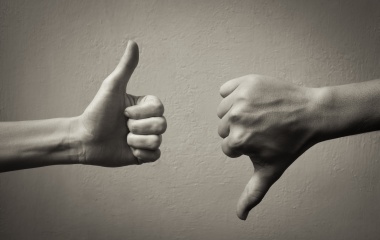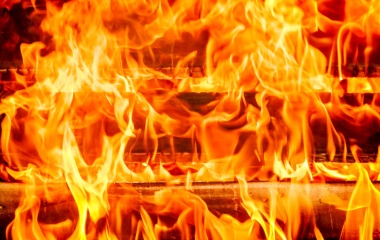
“What is lashon hara?” (Erachin 15b). This is a most reasonable question—had it been asked at the beginning of a discussion on the laws of lashon hara. However, this question appears after more than a page of Talmudic discussion regarding the prohibition of lashon hara. Why the wait[1]?
Furthermore, the answer to this question is rather opaque, to say the least. “Rava says: for example, if one says there is fire in Ploni’s house.” Abaye immediately asks, “What did he do [wrong]? He is just revealing [harmless] information”. Why and how is saying that there is fire in someone’s house lashon hara? The Gemara’s answer to this question seems to muddy the waters even more, shedding very little light on the definition of lashon hara. “He said it in a negative way, stating there is fire only in Ploni’s house, where there is meat and fish”.
Our commentaries struggle to explain this cryptic definition of lashon hara. Rashi argues that such a statement implies that this person must be wealthy, as evidenced by the fact that they are always cooking food there. Being as wealthy as they are, they should, Rashi notes, be giving more tzedakah. The Maharsha suggests that this comment is considered lashon hara because it implies that this person is a glutton, and he keeps the fire on at all times so he can eat to his heart’s delight.
These explanations, I trust you will agree, are quite a stretch. Perhaps he has a fire in his home so that he can constantly have hot food ready to be given to the many poor that ask for his help. Maybe he is giving away not too little, but too much.
And even if Rashi or the Maharsha are correct, is this the best definition of lashon hara? Why not answer by making reference to Miriam, as the Torah itself does, explaining that even though she spoke the truth and meant well, it was still lashon hara and she needed to be punished for that? Why not outline some of the parameters as to when negative speech is and isn’t allowed, or when it is mandated and when not?
It seems that our sugya must be divided into two related, yet distinct, parts. The first half of the sugya deals with what we might call “classical” lashon hara. And this type of negative speech needs no definition. To quote Potter Stewart, former associate justice of the United States Supreme Court, who in ruling on whether material was pornographic[2] and hence, not constitutionally protected under the doctrine of free speech, declared, “I know it when I see it”. When one gossips, slanders, libels or otherwise puts another down, one is guilty of speaking lashon hara. No technical details are needed, no Talmudic discussion is necessary. We know full well when we are speaking inappropriately.
Our Sages wanted, first and foremost, to focus on the severity of negative speech—that and little else. Discussing the technical details of lashon hara at this point adds little—and runs the risk of removing our focus from the importance of proper speech. Once one begins to focus on technical details, one can arrive at many ways that may technically avoid a prohibition, while still engaging in negative behaviour all the same. Technical details have their place, but not yet.
Thus, we begin with such teachings such as, “All who tell lashon hara, it is as if they are kofer b’ikkar, they deny the essence of Judaism”, or “Whoever speaks lashon hara is worthy of being stoned” (Erachin 15b).
Our Sages did not mean this literally and hence, the phrase k’eelo—as if, but not actually the same. Rather, they were engaged in rhetorical flourish in order to emphasize the severity of the prohibition. Their absolute honesty forced them to let us know they are exaggerating to make a point. Similarly, one is “worthy” of being stoned, but it would be a terrible injustice to stone someone for lashon hara.
Yet at the same time, one who engages in lashon hara is denying the essence of Judasim, of what it means to be a human being. Many of our commentaries explain that the image of G-d, which was gifted to human beings only, is most manifest in the gift of speech. It is man’s ability to communicate—a gift that seemingly knows no limits—not only with others, but with G-d, that makes us godly. Hence, the misuse of that speech puts one in the category of kofer b’ikkar.
When one thinks of stones and lashon hara, one inevitably is reminded of Moshe Rabbeinu speaking negatively against the Jewish people—“Listen, you rebels!”—and then hit the stone. It is not as if Moshe was not justified in castigating the people. Yet he was severely punished. One who nonetheless speaks lashon hara deserves, in theory, to be pelted with stones.
Interestingly, there is no hint that the rabbis are exaggerating in two other pronouncements: “Whoever speaks lashon hara, G-d says, “S/He and I cannot dwell [together] in the world” or “Whoever speaks lashon hara increases his sin to the level of idolatry, adultery and the spilling of blood”.
G-d may “literally” find it “difficult” to be in the presence of one who speaks lashon hara and may engage (vis-à-vis that person) in hester panim, in hiding His face as He distances himself from the person. And while there is no penalty issued by a court for speaking lashon hara, in G-d’s eyes it reaches the level of the three cardinal sins of idolatry, adultery and murder. These sins do not happen in a vacuum and often—especially in the case of murder—are the result of horrible speech that preceded it.
What makes lashon hara so sad is that there is no material benefit involved. When one cheats in business, eats non-kosher food, or engages in forbidden sexual activity, at least one has a tangible benefit. It may be wrong, but there is no denying that there is some tangible benefit or momentary pleasure. But with lashon hara, what possible gain does one have[3]?
“In the future, all the animals will gather and come to the serpent and say to it: A lion tramples and eats; a wolf tears and eats. But you, what benefit do you have? Say to them: And what is the benefit to the master of the tongue?” Unlike animals that can enjoy their prey, the snake derives no benefit from poisoning his victim. It is, in his own words, no different from lashon hara. You may harm others, but what have you gained?
As to understanding the fire in someone’s house—part two of this sugya—that will have to wait until our next post.
[1] We find a similar structure regarding Chanukah, where the Gemara first discusses the types of oils and wicks that may be used, when we light, how we light, and where we light, and only afterwards asks, “Mai Chanukah, what is Chanukah?” See here for a discussion of why that may be.
[2] I think the comparison of lashon hara to pornography is most apt. When gossiping about others, we are figuratively undressing them, revealing secrets that should remain hidden, or might we say, covered. Just as one’s private parts are meant to be private, so, too, is so much information we inappropriately reveal about others.
[3] While there may be no tangible benefit gained by putting others down, we elevate ourselves. As in life, so much is relative that it’s easier to put others down than raise oneself up. Doing so, however, is a bad strategy and our rabbis had harsh words for those who did so: “One who gains honour by degrading another loses his share in the World to Come” (Jerusalem Talmud, Chagigah, 10:1).



